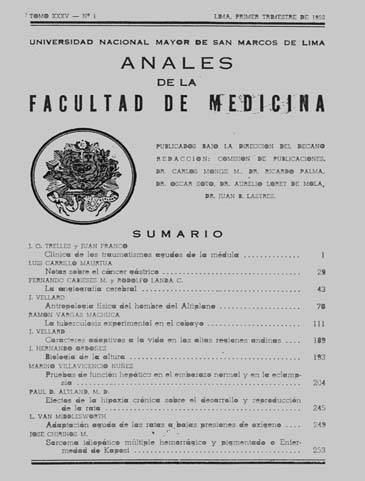Effects of chronic hypoxia on the development and reproduction of the rat
DOI:
https://doi.org/10.15381/anales.v35i1.9352Abstract
In rats exposed daily for four hours at simulated altitudes of 25,000 feet, growth was slow, delayed puberty and life span was reduced by 50%. 25,000 feet daily, exposures produce severe testicle injury, which does not improve with acclimatization. The reproduction was completely inhibited in both sexes. At 18,000 feet playback occurs with low efficiency. The reduced litter size was associated with a decreased number of successful implantations and fetal resorption. Daily exposure of adult rats to 25,000 feet produced marked testicular damage after twelve exposures. Marked lesion was produced with few exhibitions (4) when done at weekly intervals. The time must be considered in the development of testicular injury after exposure to high altitudes. After the severe testicular damage occurred in rats was only possible to complete recovery of normal structure when all exposures ended. Exposure to ten day intervals prevents the slight recovery. After producing polycythemia in rats by short daily exposures, it was possible to maintain this status polycythemic exhibitions every two or three days; Longer idle periods produced the return of normal blood picture. The main pathological findings in rats exposed daily for prolonged periods, were the presence of 1) vegetations on the heart valves; 2) fibrous and fatty changes in left ventricular wall, 3) myocardial heart and kidney, occasionally ssociates with thrombus and embolism, and 4) hematuria and enterorrhagia.Downloads
Published
1952-03-17
Issue
Section
Trabajos originales
License
Copyright (c) 1952 Paul D. Altland

This work is licensed under a Creative Commons Attribution-NonCommercial-ShareAlike 4.0 International License.
Those authors who have publications with this magazine accept the following terms:
- Authors will retain their copyrights and guarantee the journal the right of first publication of their work, which will be simultaneously subject to Creative Commons Attribution License that allows third parties to share the work as long as its author and its first publication this magazine are indicated.
- Authors may adopt other non-exclusive licensing agreements for the distribution of the version of the published work (eg, deposit it in an institutional electronic file or publish it in a monographic volume) provided that the initial publication in this magazine is indicated.
- Authors are allowed and recommended to disseminate their work over the Internet (eg: in institutional telematic archives or on their website) before and during the submission process, which It can produce interesting exchanges and increase quotes from the published work. (See El efecto del acceso abierto ).
How to Cite
1.
Altland PD. Effects of chronic hypoxia on the development and reproduction of the rat. An Fac med [Internet]. 1952 Mar. 17 [cited 2025 Jun. 6];35(1):245-8. Available from: https://revistasinvestigacion.unmsm.edu.pe/index.php/anales/article/view/9352



